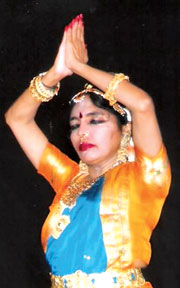Present trend in classical and folk dance forms
by Subashini PATHMANATHAN
All the classical dance forms are confined into the category of
Margi; meanwhile all the folk dances are categorized into the category
of Desi. The Desi dance form all over the world differs from region to
region, place to place, district to district, and season to season. Most
of this Desi dance forms are formulated for amusements. This particular
Pradesha folk dance according to Natya Sastra is called Desi Dance. Desi
dances are also strictly based on certain norms. Even anybody can handle
the Desi dance forms (folk dances) according to their own ideas, and
modify the costumes, makeup, and music.
 In society dance is divided into two varieties. One is classical and
the other is folk dance. Both the classical dance and folk dance reflect
the culture, tradition, religion, and regional social practices and
social background of the selective society. In society dance is divided into two varieties. One is classical and
the other is folk dance. Both the classical dance and folk dance reflect
the culture, tradition, religion, and regional social practices and
social background of the selective society.
Classical dances and folk dances have certain norms, and both provide
equal opportunity for creativity, within the limited frame work. All the
classical and folk dances have certain defined clarified items. Each
item of the classical and folk dances have their own defined order, and
use certain selected ornaments, and designed costumes and selective make
up. Similarly, each and every classical and folk dance is based on
certain selective music. Some are accompanied with vocal music alone,
and some are only accompanied with instrumental music alone, and some
more are accompanied with vocal music and instrumental music together.
Hence all the classical and folk dances have rich historical background,
and longstanding historical development.
Some of the folk dances are practised only for certain festivals and
for certain occasions by certain caste or clan.
The Margi dance form which transcends the international barriers and
boundaries and acquires the international recognition. These Classical
dances (Margi) are very polished and specialized techniques.
Most of the oriental classical dances have a spiritual and historical
background behind them. All the classical dance forms were fostered in
different regions, in different countries for centuries together. These
ancient dance forms are a part of traditional heritages, and traditional
culture. Above all, the classical dance forms are totally based and
linked with spirituality, philosophy and religion. Majority of the
traditional art community all over the world are preserving and
protecting these art forms with full devotion and with full dedication.
But unfortunately at the end of the 20th century there was a new
trend that emerged among the society and among the teachers who had
introduced a new face of dance to attract the students, and attract the
audience together. Sometimes one particular dance form is mixed-up with
numerous other classical dances that is known as the fusion dance, which
cannot be included among the classical or folk dances. These fusion
dances do not have any proper base.
In between these fusion dances, some choreographers insert and
introduce certain their own ideological creativity. Sometimes the dances
are mixed-up with numerous classical dances and also with numerous folk
dances. At the end all the dance forms lose their total essence and
purity of the art forms and also their own identity. No proper music is
adopted for these dances.
Today many modern artistes all over the world introduce numerous
modifications, and innovations, in these ancient dance forms. As the
result, they distort and destroy the whole idea of these beautiful art
forms, which were fostered and preserved for centuries by generations
and generations. The main aim of the present generation dance
choreographers introduce some new trends to attract the present ordinary
masses by introducing some cinema type of baseless dances according to
their own wishes, and ideologies, with the help of modern techniques,
such as lighting, and sound system.
Mainly some of the dance teachers try to introduce the dances for the
light music background. Even some of the choreographers introduce
dances, for certain thrilling cinema songs. All these dances are carried
and labelled under the name of fusion dance.
These fusion dances are carried out, and promoted by certain
individual dance teachers, as well as by certain organisations for
business purposes, popularity, and for entertainment purposes.
In these vivid dances, most of the dancers use real classical dance
costumes and ornaments. These types of baseless dances will not last
long, but for the time being it damages the image of the pure classical
and folk dances among the present young generation and future
generation.
Earlier music was divided into classical music, folk music, and light
music. But after some years back, pop music was quite popular among the
ordinary masses. Now it has lost its popularity. Similarly any art form
which is introduced without any proper base will not last long.
Some artistes who promote such as fusion dances and pop music for
their personal gains and, for their business purposes, will slowly and
slowly lose their own recognition.
Among all the seven Classical Indian dance forms, Bharta Natyam, is
mostly affected by this present fusion trend. Similarly for some extent
in the Sri Lankan Classical dance form - the Kandyan dance form is also
affected by this fusion trend.
|

